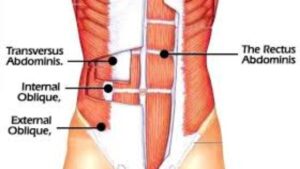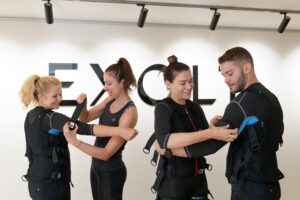Ah, the core. That elusive, magical muscle group we all aspire to conquer. Whether you’re trying to avoid looking like a flailing fish in yoga class or you’re just after that strong, stable feeling, correct core activation is essential. And guess what? EMS (Electro Muscle Stimulation) training can take your core activation to a whole new level!
SO, WHAT DOES “ACTIVATING YOUR CORE” EVEN MEAN?
Let’s clear up the mystery. Activating your core isn’t about holding your breath, bracing your abs or sucking in so hard you look like you’ve swallowed a lemon. It’s about engaging those abdominal muscles and using breathing to create intra-abdominal pressure through your waist and spine. This magical pressure is your spine’s best friend and allows you to move more effectively.
HOW EMS MAKES CORE ACTIVATION A BREEZE
With EMS, we’re not just talking about activating your core—we’re supercharging it! EMS (Electro Muscle Stimulation) utilises carefully calibrated electrical impulses to stimulate muscle contractions. This technology bypasses the limitations of voluntary muscle contractions by directly activating the motor neurons. As a result, EMS ensures a deeper and more effective engagement of your muscle fibers compared to traditional workouts. Think of it as having a personal trainer for each individual muscle fiber, guiding and pushing them to their optimal performance. By engaging muscles at a higher intensity and recruiting more muscle fibers simultaneously, EMS enhances both the efficiency and efficacy of your workouts. Here’s how you can maximise these benefits and achieve superior core activation:
STEP-BY-STEP GUIDE TO ACTIVATING YOUR CORE WITH EMS
1. Lateral Breathing: Lateral breathing is a technique where you breathe deeply into the sides and back of your ribcage, rather than just your belly or chest. Imagine you’re filling up the space around your waist with air. As you inhale, your ribs expand out to the sides and back. As you exhale, they gently contract. With EMS, this process is enhanced as the stimulations work in tandem with your breath, making your core engagement more intense and effective. When focusing on core strength with EMS you want to inhale before the stimulation kicks in, then exhale as the stimulation ramps up. You then need to focus to continue inhales & exhales DURING stimulation and AVOID HOLDING YOUR BREATHE!
2. Engage, Don’t Brace: Avoid the old “suck in” method. Instead, think of wrapping your muscles around your torso like a corset. EMS amplifies this effect, activating those deep core muscles (hello, transverse abdominis!) without you having to think too hard about it.
3. Feel the Burn—Safely: EMS training ensures you’re engaging the right muscles. If you feel your lower back, neck or hip flexors taking over then you need to make an adjustment to either the exercise positioning or intensity of stimulation across other muscle groups. With EMS, you can adjust the intensity to target your abs precisely, keeping those pesky lower back and hip flexors out of the equation.
THE ABS BREAKDOWN: MEET YOUR CORE TEAM

Did you know that you actually have 4 layers of abdominal muscles? Different exercises will focus on different muscles, but the amazing thing about EMS is that we are almost forcing you to work all 4 layers, even when you yourself may not have a strong connection to one particular layer.
Transverse Abdominis (TA): Think of this as your natural corset. With EMS, you’ll feel this muscle working hard as it stabilises your core. Draw your hip bones together, like they’re meeting under your belly button, and let EMS enhance this contraction.
Internal and External Obliques: These are your body’s built-in stabilisers and twisters. EMS makes sure they’re firing correctly, whether you’re doing a side plank or twisting like a wet towel. Engage your lats, pull down through your shoulder blades, and let EMS handle the rest.
Rectus Abdominis: The famous six-pack muscle. EMS helps you maintain a strong, flat contraction, ensuring that every curl and crunch is supercharged. Exhale as you curl up, keeping those lower abs flat and your lower back firmly on the floor.
COMMON MISTAKES AND HOW TO AVOID THEM WITH EMS
If you feel any of these niggles during core focused exercises its important you firstly reset if that’s what is needed. Secondly you should alert your EMS trainer. We want your focus on the core… so if the neck or lower back are taking over… then WE CAN FIX IT! An adjustment to the intensity in other muscle groups can set you up better to focus on the core or an adjustment to the exercise can take pressure off the wrong place. With EMS You DO NOT NEED TO OPT FOR THE DIFFICULT EXERCISES to get the results. You will feel, even with a simple imprint of the spine onto the floor, a huge level of core activation through EMS stimulation alone. If bringing 2 legs to table top is giving you back pressure, then keep one or both feet down.. because you are still getting a core workout without them lifted.
Neck Gripping: If your neck is doing more work than your abs, it’s time to adjust. EMS keeps your core engaged so your neck can relax. If supporting your neck helps then do so. If the trainer says lift shoulders off the floor and this isn’t right for you, then keep that head down.
Lower Back Pain: Feel it in your back? Your core might not be fully engaged. EMS helps keep your spine supported and your core muscles doing their job. If there is any lower back pressure then take a step back and find a position where your back feels supported.
Hip Flexor Overload: Sore hip flexors are a sign your core needs more activation. EMS ensures your deep stabilisers are activated, reducing the load on your hip flexors. If you are feeling fatigue or pressure on the hip flexors then take a step back with the exercise and put your leg down on the floor for support.
TIPS FOR MAXIMISING CORE ENGAGEMENT WITH EMS
Abdominal Doming: Notice a triangle shape poking out of your stomach? EMS normally helps smooth out this doming by ensuring even muscle activation. If you are seeing this then focus on flattening your stomach by imagining you’re waist is wrapped tightly by an elastic band.
Lumbar Curve: When in tension with EMS you want to really focus on drawing your lower back into the floor if lying down, or into a neutral position if in a plank/side plank position. Some exercises where 2 legs are lifted off the floor can lead to excessive arching in the back. So if you feel this then take a step back – drop a leg, drop to knees or do what you need to keep the lower back comfortable.
FINAL THOUGHTS
EMS is like having a cheat code for perfect core activation. It ensures every muscle fiber is engaged, making your workouts more effective and efficient. So next time you’re in a plank or twisting into a side plank, remember: with EMS, your core is not just activated—it’s SUPERCHARGED! 💪⚡








